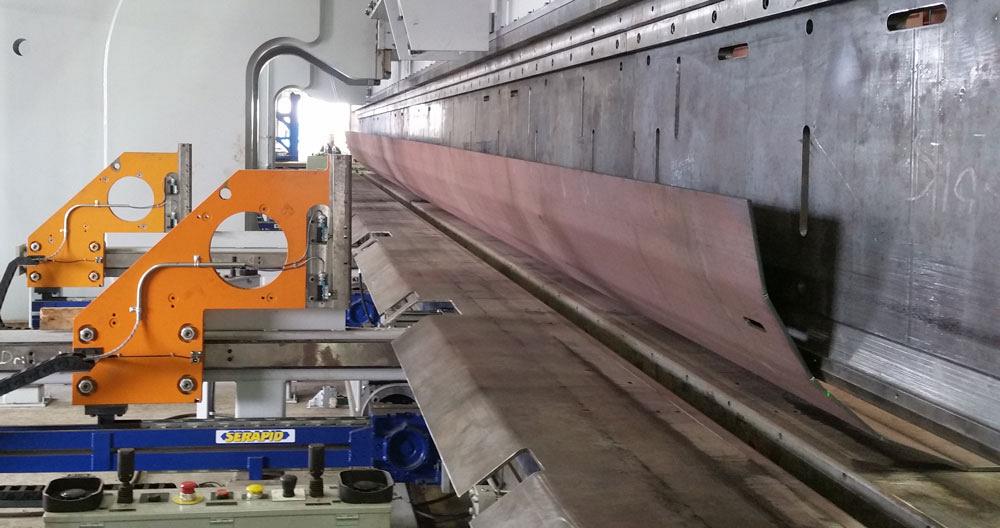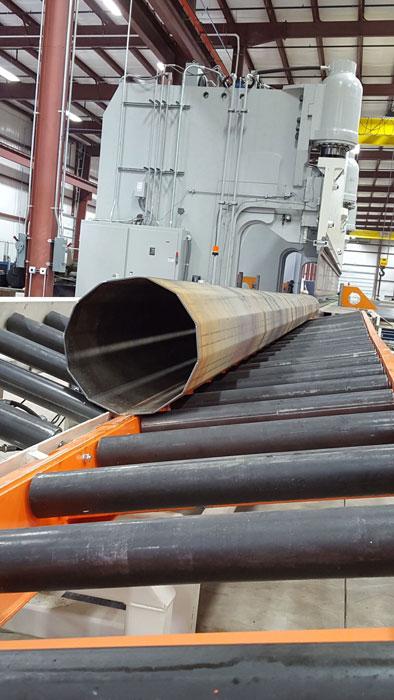Sales Manager
- FMA
- The Fabricator
- FABTECH
- Canadian Metalworking
Categories
- Additive Manufacturing
- Aluminum Welding
- Arc Welding
- Assembly and Joining
- Automation and Robotics
- Bending and Forming
- Consumables
- Cutting and Weld Prep
- Electric Vehicles
- En Español
- Finishing
- Hydroforming
- Laser Cutting
- Laser Welding
- Machining
- Manufacturing Software
- Materials Handling
- Metals/Materials
- Oxyfuel Cutting
- Plasma Cutting
- Power Tools
- Punching and Other Holemaking
- Roll Forming
- Safety
- Sawing
- Shearing
- Shop Management
- Testing and Measuring
- Tube and Pipe Fabrication
- Tube and Pipe Production
- Waterjet Cutting
Industry Directory
Webcasts
Podcasts
FAB 40
Advertise
Subscribe
Account Login
Search
What you need to know about tandem press brakes
4 questions to help fabricators understand what these brake setups can do for them
- By Chris Robinson
- February 4, 2019
- Article
- Bending and Forming

Tandem press brakes can be used to bend really long parts, as long as 60 feet in some instances, or they can be used independently to bend smaller parts. The combination offers fabricators flexibility in the jobs they can process in their bending departments.
A large press brake is not the only way to bend a large-sized part. Press brakes can be coupled to work in tandem, which might help increase productivity and throughput.
When might you need a tandem press brake? Any shop evaluating a need for tandem press brakes should start with understanding how they work, the proper applications for them, and any material handling options that might further increase productivity.
The answers to the following questions can help you to figure out if two press brakes are better than one large one.
1. How do tandem brakes work?
Like most single brakes, tandem brakes also are CNC. Ram depth accuracy and repeatability are achieved with scales and linear encoders. These components evaluate the position of the ram multiple times per millisecond and direct that information back to the CNC, which then governs the hydraulic system powering the machines. Instead of reading two scale positions for a single machine, tandem brakes read the position of four scales and adjust accordingly.
The machines can be controlled either from a single station to act as one long press brake, or they can be operated independently as two separate press brakes. Most CNCs even have an option that allows part programming to be shared across both machines.
When the brakes are operated as a tandem set, it is critical that both machines are set up and calibrated properly. While important for single-machine setup, calibration is even more crucial for tandem brakes. This starts with the mechanical features of the machines: the bed, ram, and tooling. If these items are not properly aligned, quality bends will not be achieved. Multiple methods are available to ensure precision alignment. Reputable OEMs and rigging companies will be able to guide you through this process.
Once the mechanical features are in sync, it is imperative that both machines be functioning properly. Any problem one of the machines experiences will affect the operation of both. For instance, if a scale is misrepresenting the position of the Y1 cylinder on one side of the tandem, the tandem press brake will not be able to deliver consistency in the final bend angle across the length of the entire part. Additionally, if auxiliary components, such as backgauges and crowning devices, are employed on both machines, these will have to be working in precise conjunction with one another to ensure proper part quality.
Most of the same rules of operating single machines should be applied to tandem brakes. The first thing to keep in mind is the tonnage rating of the machine. A common misconception is that having two machines in tandem doubles the tonnage regardless of where the bend takes place. Full, combined tonnage of the machines applies only to full-length parts. Attempting to apply full tonnage of both machines across parts that don’t run the length of the machines can create issues with premature wear of components.
Additionally, exceeding the tons-per-foot rating of the tooling either will cause wear or, more catastrophically, crash punches and dies. Off-center loading of these machines also can put additional stress on components such as gibbing and cylinder seals. Use common sense to avoid problems. If an operation would create problems for a single machine, it probably will for tandems as well.
2. What applications are best for tandem brakes?
From low-production, high-variable job shops to fabricators with a more dedicated process, tandem brakes can be the ideal tool, but it is all about the application. When thinking about adding tandem brakes, consider the following advantages.

Attempting to apply full tonnage of both brakes in a tandem set across parts that don’t run the length of the machines can create issues with premature wear of components.
Flexibility. Tandem brakes give you the ability to provide flexibility to your customers by offering a one-stop shop for a variety of parts. For instance, if a job shop has two 500-ton, 20-foot brakes operating in tandem, it not only can produce a part up to 40 ft. long, but also employ both machines independently to double output for parts 20 ft. or less in length.
As business conditions change, job shops need to be agile and often find themselves taking on a wider variety of jobs. Tandem brakes offer the flexibility to keep future business options open.
Additionally, you might be interested in exploring the option to sync a new machine with an existing unit to provide this flexibility.
Risk Aversion. Buying a tandem machine configuration allows you to potentially avoid risks. By essentially having two brakes, your shop still can produce smaller parts on one brake in the unfortunate event that one machine has downtime.
Speed. Two smaller brakes are faster than one large brake. While bending time might not be the most critical component in the production process (see question No. 4), higher speeds can allow shops to produce more parts.
Machine Costs. A smaller, standard machine might be cheaper than a larger, custom machine. While this is not always the case, two standard brakes might prove less expensive when evaluating the total cost of ownership.
Auxiliary Costs. The cost of an additional brake, or tandem brakes, is only a percentage of the total cost of the project. Before purchasing any piece of fabrication equipment, conduct a thorough evaluation of auxiliary costs. How does the transportation cost differ for one large machine relative to two smaller machines? Will special permits be required? How does the rigging cost compare for each machine type? Will additional foundation preparation work be needed for one type of configuration relative to another? What about incoming power and hydraulic oil requirements? Understanding all costs associated is the only way to accurately calculate return on investment.
3. Which applications are unsuitable for tandems?
Tandem brakes are a great way to create a lot of bending length, often up to 60 ft. or more. However, with a tandem brake set, each machine still has side housings. Most OEMs offer custom throat dimensions, but when you are bending very wide parts, the side housings still get in the way. While bending wide parts reduces the need to weld smaller parts together, you should still be aware that a tandem set with additional side housings might not be the best fit for its application.
Also, buying a tandem set means purchasing two brakes. There are now twice as many parts that could potentially fail. Maintenance of tandem sets is more critical, as noted previously.
4. What material handling options are available for tandem brakes?
Do they differ from single brakes?

A conveyor attached to a tandem brake set can help to reduce material handling time and increase bending uptime.
Transporting material to and from brakes is often the most time-consuming part of the process. Typically, a high-production shop is doing great if it is bending 20 to 25 percent of the time. With large parts requiring a tandem set, the percentage of time spent bending metal is even lower.
As with most metal forming machines, the most commonly used auxiliary component is a crane. With tandem sets employing an additional crane might be necessary, especially when both machines are operated independently. Buying tandem brakes and producing additional parts only to be left waiting for crane time can increase labor time and add cost to jobs.
Other auxiliary components can be used, especially in production shops that use the tandems in a dedicated process. Heavy-duty positioning systems not only help move and adjust heavy steel plate, but also can be used as front- and backgauging systems. Many OEMS also offer part ejection systems that extract parts out of the end of the machines. Adding conveyors and collection tables at the entrance and exit sides of the machines can save time and money as well.
Although some auxiliary components can have a hefty price tag, you should consider potential increases in productivity and worker safety as well as labor savings when calculating the ROI for a tandem system.
Purchasing Criteria
Before purchasing any machine tool, analyze as much information as is available about your current state of business. What parts are you currently producing? How costly are these parts to produce? How sustainable is it to continue producing the parts with the current production process?
Additionally, try to understand the future of your business by asking additional questions. Is there a more productive, less costly way to produce current parts? Are there new markets to enter through the acquisition of a new machine? How has the current business changed over the past 10 to 20 years, and where do we think it will go in the next 10 to 20 years?
Acquiring tandem press brakes, like most machinery purchases, is a big financial decision. Starting with a clear picture of the current business environment and answering questions about the potential of future business will help you make a decision that ultimately will increase production and profitability.
Chris Robinson is sales manager, Pacific Press Technologies, 714 N. Walnut St., Mount Carmel, IL 62863, 618-262-8666, www.pacific-press.com.
About the Author
Related Companies
subscribe now

The Fabricator is North America's leading magazine for the metal forming and fabricating industry. The magazine delivers the news, technical articles, and case histories that enable fabricators to do their jobs more efficiently. The Fabricator has served the industry since 1970.
start your free subscription- Stay connected from anywhere

Easily access valuable industry resources now with full access to the digital edition of The Fabricator.

Easily access valuable industry resources now with full access to the digital edition of The Welder.

Easily access valuable industry resources now with full access to the digital edition of The Tube and Pipe Journal.
- Podcasting
- Podcast:
- The Fabricator Podcast
- Published:
- 04/16/2024
- Running Time:
- 63:29
In this episode of The Fabricator Podcast, Caleb Chamberlain, co-founder and CEO of OSH Cut, discusses his company’s...
- Industry Events
16th Annual Safety Conference
- April 30 - May 1, 2024
- Elgin,
Pipe and Tube Conference
- May 21 - 22, 2024
- Omaha, NE
World-Class Roll Forming Workshop
- June 5 - 6, 2024
- Louisville, KY
Advanced Laser Application Workshop
- June 25 - 27, 2024
- Novi, MI































